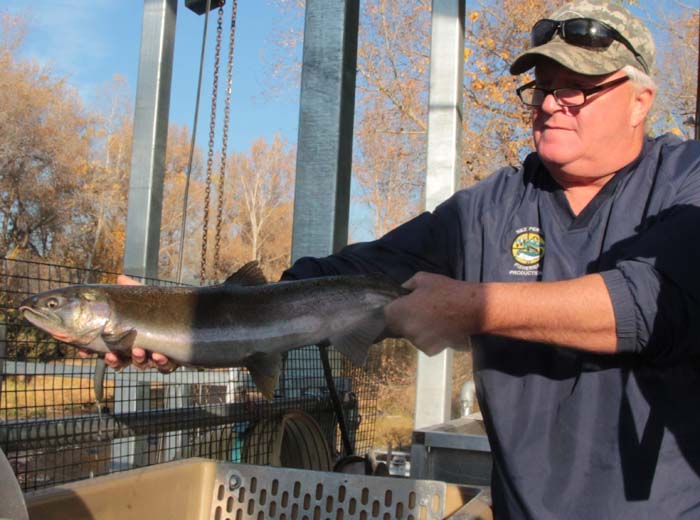Coho salmon come home to Lostine River after 40-year absence
Published 11:05 am Wednesday, October 24, 2018

- Coho salmon come home to Lostine River after 40-year absence
After a nearly 40-year absence, the first adult coho salmon entered the mouth of the Lostine River Sunday night. The silvery female is returning to the river where she was released as hatchery smolt in 2017.
According to Rick Zollman, production supervisor at the Nez Perce Tribe’s Lostine River weir, the female was 57 centimeters long, healthy and ripe with eggs. Just a day later, a 71 centimeter male coho found his way into the fish trap at the mouth of the river.
In an email Tuesday morning announcing the return of the first two fish from the 2017 release, Jim Harbeck, manager of the Nez Perce Tribe’s Joseph Fisheries office, joked, “Now they’re a couple.”
What isn’t a joke are the odds these fish overcame to get to the Lostine. Part of a reintroduction project sponsored by Oregon Department of Fish and Wildlife and the Tribe, this first couple of adult coho were some of 500,000 smolt, juvenile salmon ready to migrate to the ocean, released during a ceremony March 9, 2017.
Becky Johnson, Nez Perce Fisheries production division director, said her staff has been watching for data collected from tagged adult fish as they pass over the eight dams, from Bonneville on the Columbia River to Lower Granite on the Snake, from the Pacific Ocean to the Lostine River.
“We are holding our breath watching them come over the dams,” Johnson said. “So far we estimate about 2,100 have cleared the Bonneville and 300 have crossed Lower Granite.”
Adult coho trapped at Bonneville Dam are used as brood stock for hatchery supplemented coho salmon projects around the Northwest, and their offspring are raised at the ODFW Cascade Hatchery.
Johnson said she is pleased with the return so far. As hatchery-raised fish reproduce in their new natal waters, each generation gets bigger and stronger and becomes better swimmers.
Johnson said, “It is encouraging (especially because) these fish came from fish trapped at Bonneville. Their parents didn’t swim over all those dams and they were raised in a hatchery, put on a truck and transported to Lostine without being acclimated.”
While the fish came from brood stock and were raised in a hatchery, the method mimics nature. According to Zollman, wild coho spend 1-1/2 years in a river and 1-1/2 years migrating to the ocean and back to the river to spawn.
Just like clockwork, the first couple of mature adult coho, released at the age of 18 months, returned to the Lostine a day apart a year and a half after their release.
“It’s an awesome testament to how tough salmon are,” Johnson said.
Making the return of the Lostine coho even more remarkable, Johnson said, are the abysmal ocean conditions affecting all salmon and steelhead species. She said a stretch of warm water has been sitting off the coast of Alaska, Canada and Washington for a couple years, and the ocean water is getting more acidic with climate change.
“Fish get out there and there’s no food,” Johnson said. “It’s a tough place to make a living.”
Even though the warm water has started to dissipate, Johnson said ocean scientists are now talking about hangover effects.
“It takes a while for the prey base to build back up and the salmon species to get back in shape,” she said. “That’s what makes us feel even better about the Lostine return — given those terrible conditions these fish survived.
The state has been monitoring the demise of coho since they disappeared from the Grande Ronde Basin more than 40 years ago.
Jeff Yanke, the ODFW fish biologist in Enterprise, said, “We’re really happy to see this pay off and (are) super curious how it plays out from here and where else they show up in the basin.”
Yanke said Fish and Wildlife captured the brood stock at Bonneville, raised them to smolts and transported them to the Lostine. Now it’s up to the Tribe’s Lostine weir team to monitor the returning adults.
The state and Tribe’s eventual goal is to build up a run and provide a fishery, Johnson said.
“Our target return is 500 adults from each 500,000 smolt released. That’s what we need for brood stock,” Johnson said.
After five years of releasing juvenile coho and monitoring the adult returns, the state and the Tribe will have to make a decision whether or not to continue the project.
“Money is tight and we need to put it where we can make the most of it,” Johnson said.
The Tribe’s Lostine weir is funded by Bonneville Power Administration for Snake River spring chinook and steelhead research, species listed as threatened on the federal Endangered Species List. Johnson said she is grateful for BPA’s permission to use the weir for coho research, a species not protected under the ESA on the Lostine River.
Johnson said the coho project is funded through the Mitchell Act and Pacific Coastal Salmon Recovery Fund, both administered by the National Oceanic and Atmospheric Administration.




